Here is the Volume 6 (1st. Volume) of American Football from When you watch something, visit us first! Mr. Yorihisa SEKIGUCHI, former Head Coach of the “ThreeNailsCrowns “, the American Football team of J.F.Oberlin University told us about the Tactics of Offense (OF) & Defense (DF) of American Football. This is the complete version of Part 6-1, 6-2 and 6-3 on our YouTube channel.
In the American Football Vol.5, we learned about the plays of Special Team.
Mr. Yorihisa SEKIGUCHI, former Head Coach of “Three Nails Crowns,” the American Football team of J. F. Oberlin University, told us again about the tactics of Offense and Defense.
.png)
Part 6-1:Tactics of Offense and Defense (Formation)
When the Offense (OF) selects the play, how to create mismatches is important.
Mismatch in speed
For example, suppose the Defense (DF) is defending in this formation. This Cornerback (CB) is to cover this Wide receiver (WR). This Outside Linebacker (OLB) is to cover this WR. And, this CB is to cover this WR. Then, a mismatch will occur between this player and this player.
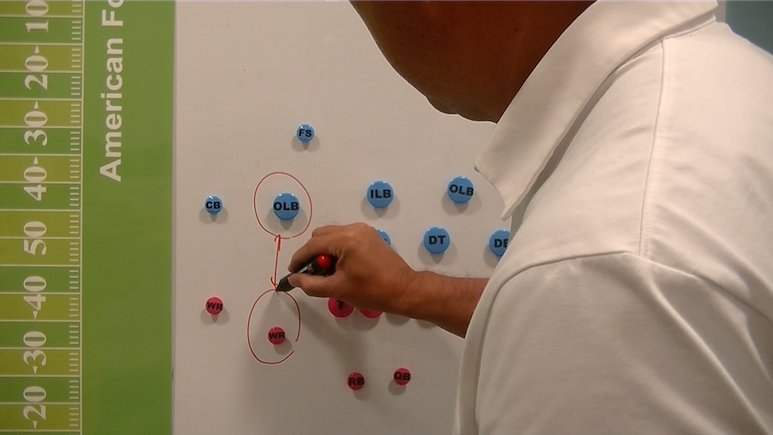
Linebacker (LB) is a position to defend both Run play and Pass play. WR, on the other hand, are specialized in catching passes, so they are basically fast and quick. Players who can defend both Run plays and Pass plays must still have size and be good at tackle, so WR are often superior in speed.
Therefore, if DF is covering by 1-on-1 scheme here, to make WR move left or right at the early timing, which is often called “Break,” to make it difficult for OLB to cover is the mismatch in speed, the first mismatch.
Mismatch in number of players
Then DF will put in a Nickel Back (NB). Then the mismatch just mentioned is no longer here.
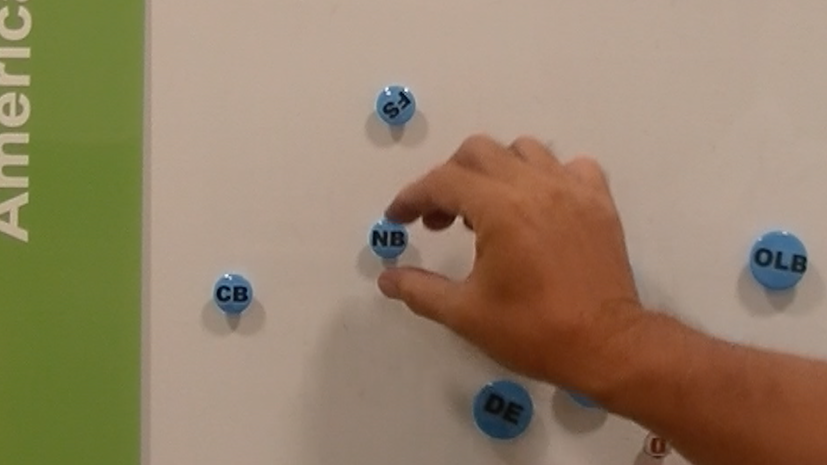
Then, OF has the new option of doing a Run play. Because, there are 6 OF players who will block the Run play, and there are also 6 DF players who are expected to participate in blocking against them, so both OF and DF have the same number of players, and if the numbers are same, OF has the advantage.
If each OF player can properly block DF player in charge and win 1-on-1 basis, Run play will be definitely in success. And, talking about Run play on which side is more effective, for example, in this formation, DF players on the right side are these 5 plus this Inside Linebacker (ILB) in the center, so there are 5.5 players. 5.5 on the right side and 5.5 on the left side.
Then, let’s count how many OF players are on the right side. In addition to these 4 players, there are 4 in the center, therefore, they have 6. They have 6 players on the right side. In this situation, it is definitely better for OF to do Run play on the right side. If it is the other way around, OF should do it on the opposite side.

Thus, the side of Run play may be considered depending on where DF players are located. OF always considers to create such mismatches in number of players.
Mismatch in physique
Tight End (TE) are generally big players, and even TE in Japan are usually over 180cm (approx. 6’). TE in NFL would be at least 190 cm (approx. 6’3″). Of course there are TE who are about 2 meters (approx. 6’7”) tall, and they have good physiques, can block, and can also enter into the Pass course. In a sense, they are like Supermen.
For example, I think if Mr. Shohei OHTANI is an American Football player, he should play Quarterback (QB) or TE. He is over 190cm tall and an athlete. He is also muscular and strong, so I think TE is the most suitable position for him.
And, what the advantage of TE is their size. If these 6 DF players defend Run play, then it is (Strong) Safety (SS) who covers TE going out to the Pass course. SS are basically smart, fast, and good at tackle, but they are often not that big.
So, when defending Pass to TE, SS can be better than TE in speed, but if Pass is thrown higher than his head, he is no match. For example, if TE turns sharply around here and put SS in his back, TE will surely catches Pass.
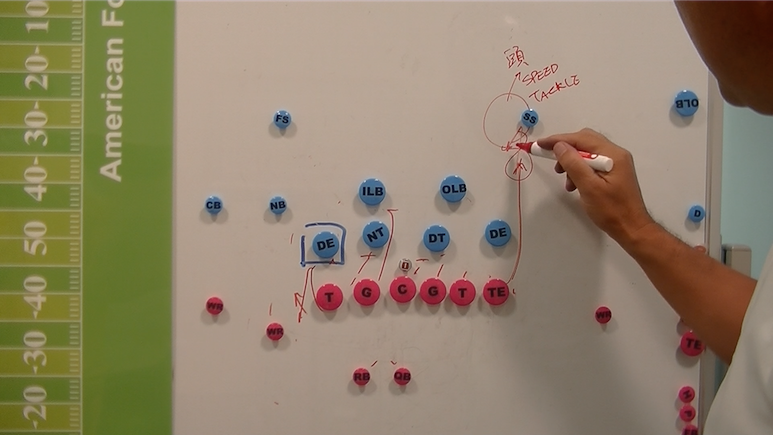
So, there is mismatch in speed , then the mismatch in the number of players, and mismatch in the physique. OF takes these considerations into account when they set up the plays.
Adjustment to the opponent’s adjustment
Formation like this which includes 1 TE and 1 Running Back (RB). This is a relatively balanced formation. When OF gets to 3rd down & 10 yards to go, it is more advantageous to put in a lot of fast players such as WR to do Pass play, so they are to put in a 4th WR for example. If DF looks at OF formation and assumes there will be a lot of possibility of Pass play, DF will respond by putting in Dime Back (D) player.
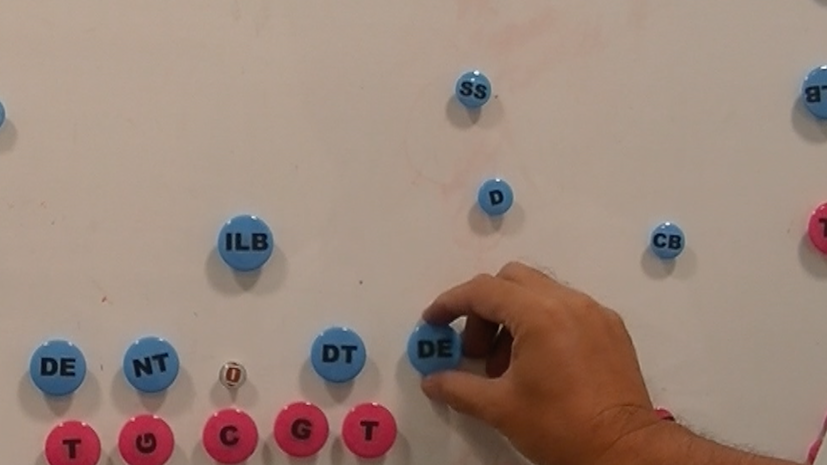
This is repeated to each other. DF is only to adjust and decide their members after looking at the members of OF. For example, in such a balanced formation, DF will often defend in a balanced way, so as OF, they may move 1 WR to the right side to make an unbalanced formation of 3 players on the right side and 1 player on the left. If so, how will DF respond to it?
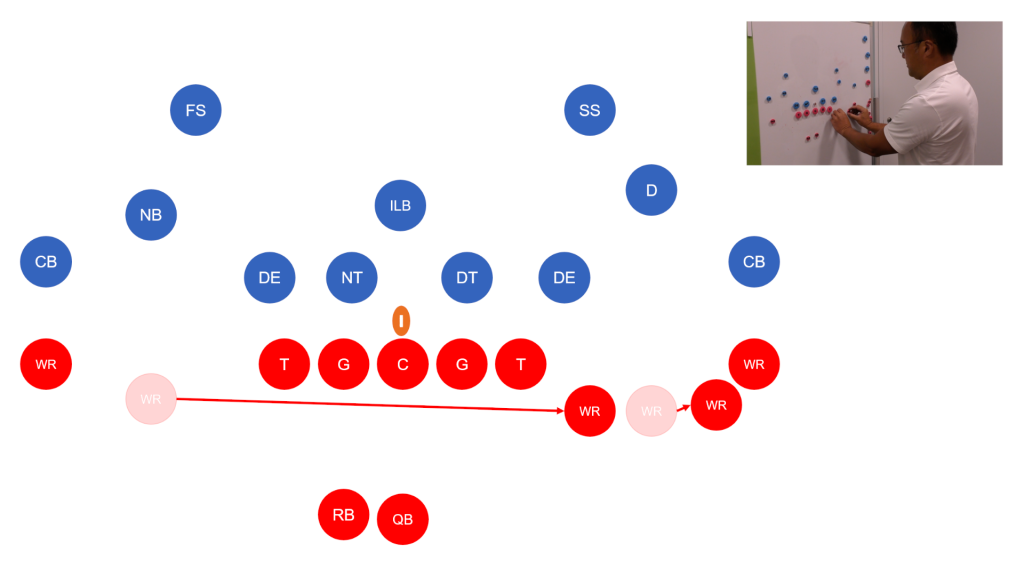
DF may respond by shifting these players slightly, or they may move players from the other side, or they may move S like this.
If OF unbalance their own formation, DF must also unbalance theirs to adjust, so OF may choose an unbalanced formation instead of a balanced formation like this situation. The strategies and tactics of both teams will change, always taking these matters into account.
Special Formation
When OF sets up a formation like this, DF naturally assumes that OF will probably do a Pass play. Because there are 4 WR. In other words, it is because there are fewer players to block the Run play.
Therefore, OF naturally does not want DF to know whether to Run or Pass as clearly as possible, so a special formation with 2 TE, 2 WR, and 1 RB is conceivable.

This formation is hard to play as DF. It is because OF has 4 players who can catch the pass. They also have players who can run with the ball. And these TE players can also block. With this formation, there are 7 routes to run with the ball, called “Gap.” Adding TE here to this formation increases the number of Gaps to 8. The most common DF strategy these days is “Gap Defense”, which is the idea that DF stops a run play by blocking 1 Gap by 1 DF player, so if another TE comes in here, DF could also bring in a bigger player. This is another way of thinking about DF since there is one more Gap.
But by doing so, DF has to reduce one more DB player, which makes it terribly hard to cover these 4 WR, so when DF thinks about this, DF cannot generally increase the number of big players in front line, other than DF close to the Goal line. Then how DF responds is often to involve this Safety (S).
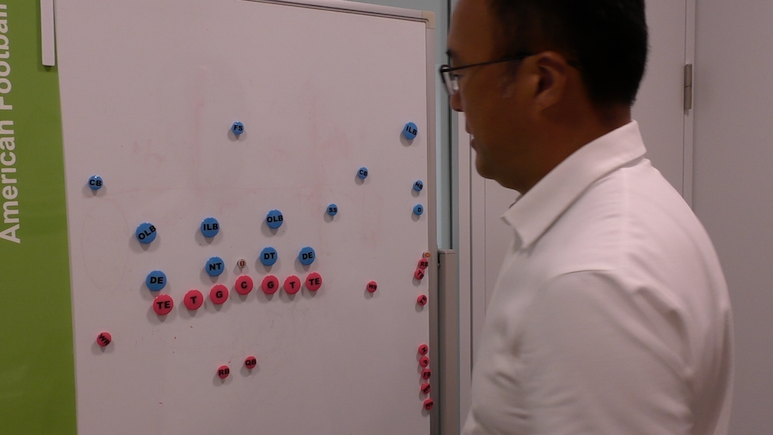
This invariably creates a situation where 1 Gap must be covered by a weaker player, or, without S, 1 Gap has no player to cover it. For example, there is no player to cover this Gap. Then, when the RB with the ball comes to this Gap, CB or Free Safety (FS) here with their best has to cover such Gap and tackle RB. DF has to cover it with this kind of player movement.
If there are 2 good TE in OF, they can take a formation that will give them an advantage against DF. This is also the case.
Part 6-2:Tactics of Offense and Defense (Response by Defense)
Excellent Defensive (DF) player
For example, if the players are located in such a formation, Mr. Aaron DONALD, for example, would always be blocked by 2 OF players, so it would be the same as if this Gap no longer exists. Then, Gap Defense can be established without problems by having each player covers 1 Gap respectively.
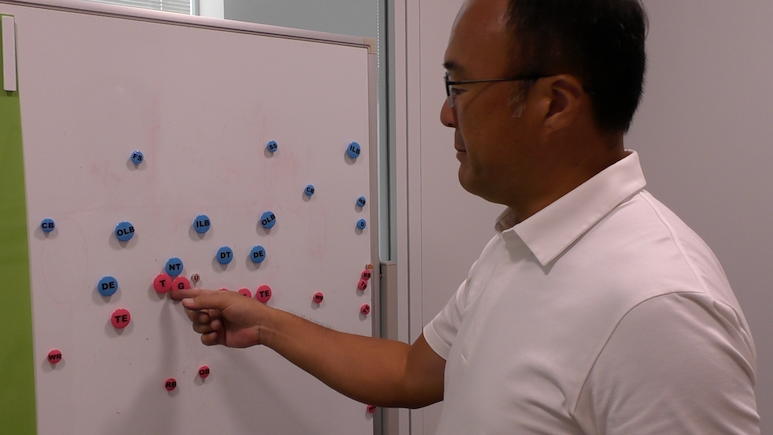
If DF has a player who can definitely win 1-on-1 basis, OF has to allocate 2 players against him, so DF’s idea is that they can take advantage by using such a Superstar well.
Then, talking about where to have such Superstar player would be advantageous, let’s say DF has an extremely talented CB player. If this CB is a player who is absolutely unbeatable in a 1-on-1, DF will isolate the area where he plays. The area with a “battle”. And in this area, DF makes CB always play 1-on-1 with WR. Because as DF, they are counting on this CB to absolutely win. Then, this situation is often called as “Shutdown Corner,” and DF will take the form of a ”10-on-10″ match in the other area.

As DF, how to defend a large area is always a proposition they have to think about. If DF plays tag in a 100 yard area, DF will never win. But if they can leave 1/3 of the field to CB, then only the remaining 2/3 of the field needs to be defended by 10 players. With 1 Superstar like this, 1/3 of the field can be left to a talented CB, and the rest of the players can cover the rest of the small field. This is the kind of football that can be played.
There are many possible ways in which DF can defend against OF, depending on if DF has a talented player at Defensive Tackle (DT), as I mentioned earlier, or if they has one at Defensive Back (DB), and teams with players who can alway win 1-on-1 basis is quite strong. Sometimes it is inside players, such as LB, and sometimes it is the outside players. DF, especially Defensive Coordinators (DC), are always thinking about what kind of Defense could give themselves an advantage over their opponents OF.
Adjustments by Defense (DF)
The most important feature of American Football is that OF always has the right to decide when to start each play and what play to make. The DF can only adjust.
Players make Huddle before each play. It is normal to have 5 Offensive Linemen (OL) in Huddle, but let’s say OF has many WR like this. Then it looks like there is a high possibility of Pass play. Now let’s say OF puts in 1 TE. With this lineup, it looks like there are quite a few possibilities for Run plays.
Then, if OF puts in another RB, i.e., Fullback (FB), it looks like there are much more Run plays.
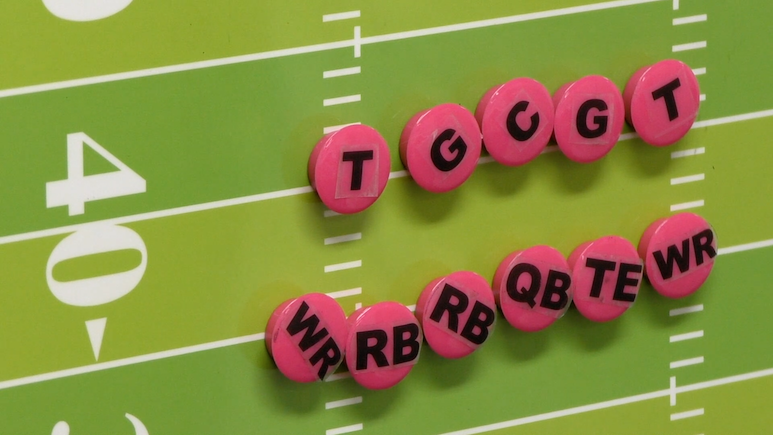
So the Coaching staffs on DF sideline are watching OF huddle very throughly which players are participating in it. Coaches with intercoms from the top of the stadium often use binoculars to see what OF player’s number is in Huddle and decide on the DF’s signals depending on that member.
So the signals of DF play is always decided after those of OF. Or some coaches call DF play after OF is in position, so DF players are always watching the sideline and waiting to see what signals come up to play.
In this sense, the Tactic of Offense and Defense in American football is like a game of “rock, paper, scissors,” and is a “Guessing game” so to speak, in which both teams must make instantaneous decisions based on the information they are given, what kind of members their opponents have, what formation they are in, how they tend to play in such formation, and so on.
OF surely knows that this is what DF is doing, and even if they know this, there is a Tactics on every play to decide whether to go for it with force or to outwit the opponent.
Part 6-3:Tactics of Offense and Defense (Tricks by Offense)
Shift and Motion
I think this formation probably narrows OF play down to a few options, but an interesting one, for example, is when Tight End (TE) shifts. In this formation, there are 3.5 OL on the side with TE while Center (C) in the middle. Then, of course, there are 2.5 OL on the side where there is no TE.
Suppose this TE shifts in this way at this time. Only with this move, Strong side has been changed, and this side suddenly has more players.
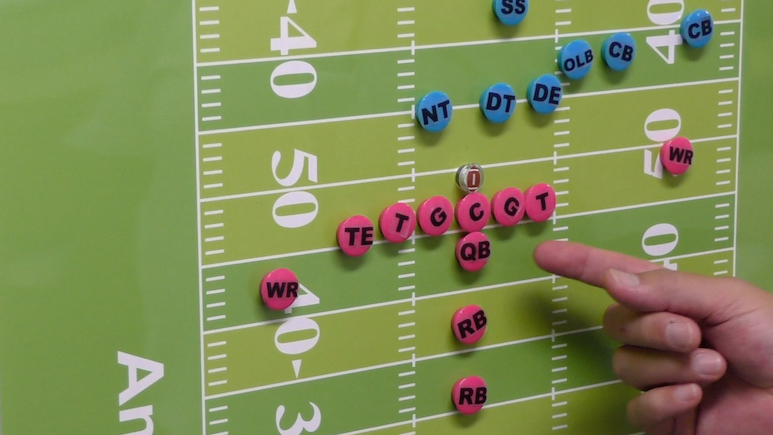
Then, though DF thought there are more OL on the right side before such shift, now there are more OL on the opposite side because of the movement of just 1 TE, so DF has to invert.
In addition to this, if this WR motions this way from this situation, it would seem that OF would come from their right side in Pass play as there are more WR in such side, though OL is more numerous on the left side.
DF, on the other hand, has to instantly analyze and determine what OF intends to, with the information of what play OF has played in the past with this formation, this motion, and this shift, and use such information in signaling. This is called “Adjusting,” especially Safety (S) player do when they can assume that OF is probably more prone to this type of play when OF did it this way on past games. Then the current signal in DF is this, but the moment OF makes a motion, the sign is nullified.
Then, to change this signal, the players in backwards, such as Inside Linebacker (ILB) and/or S, adjusts the signal by communicating it very loudly in the field. They tell the other teammates to stop using the original signal and change it to another signal, or to go with this original signal basically, but change a part of it like this.
There are cases that it may be decided in advance within the team. Adjustments are basically made by the players themselves, so the player changing signals on an adjustment is like a “Coach on the field.” In some cases, such players communicate with the coach on the sideline and decide to defend in this way for this type of play.
The interesting thing about this is that, for example, in the previous series, the opponent’s OF was playing a completely new formation. When DF tries to confirm with their coach how to handle it as they have never seen this formation before, but if OF is too “low-key” and kicks a Punt only with 3 plays, they may not be able to confirm about it within DF players. Then DF has to come onto the field again without being able to properly adjust, and it is relatively common for the opponent’s OF to proceed with the same play, so I think such a balance of OF and DF is also important.
Therefore, in student games, for example, when DF is getting a lot of one-sided points, OF often may not be getting any 1st Downs, and even though the ball comes to OF, they have to kick Punts in every 3 plays, and if so, DF players cannot get much rest after returning to the sideline and have to get on the field again without being able to decide how to adjust to the new play by OF.
Plays to show and to hide deliberately
OF always has a play that sets up for a special play that they want to make somewhere without fail.
For example, if OF prepares a play to execute for a Touchdown when the ball advanced to this point, i.e., 20 yards more or Field Goal range, and such play is a long Pass to WR after showing the fake of a Run play, OF may do another form of Run play around this area to make it work.
The opposite is also true.
For example, let’s say that when OF advances to this point, i.e., when they enter the Red Zone, OF definitely wants to play Run play. It is relatively important for OF to throw as many Passes in this area, especially long Passes, because they have an Ace RB. If the same plays, for example, Run plays, continue all the time, DF will tend to be a “Forward-oriented DF.”
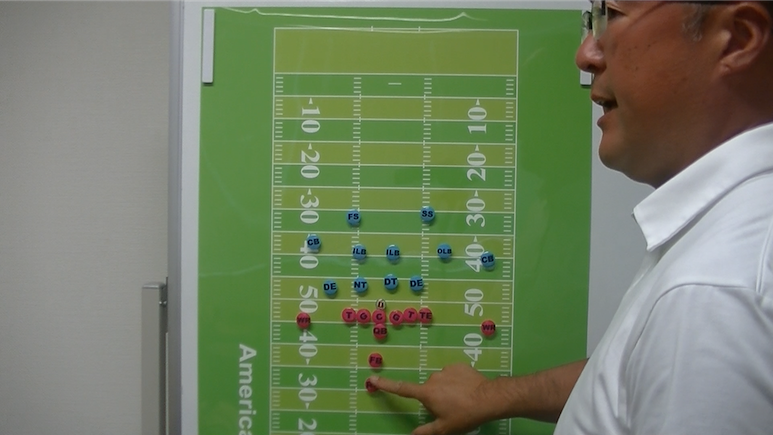
Then it would be hard for OF to advance Run plays. It is very important for OF to make Defensive Backs (DB) always be in mind that OF may make a Pass play and that OF may be always thinking about going behind them.
For example, if this S is aggressively coming up to stop such a play when OF makes a Run play on a side with more OF players, then OF will definitely throw Passes to behind such S. If many passes are thrown to behind such S, this S will not be able to come up aggressively. It is very important for OF to make DF check the play first and then move, i.e., not move it as fast as they can.
One major proposition for OF is to create a situation where DF players cannot always play at 100%, thinking that this is probably the play OF will make, but maybe they will make a different play. Since OF often has some plays they will surely want to use in some situation, they may choose a specific play in this area that sets up such play for success.

Sometimes such a play is a Run play, sometimes it is a Pass play, sometimes it is a long Pass play, and sometimes it is from the same formation, with the same shift, with the same motion, with the same composition of members, or may be a Pass play with a fake of the Run play that OF want to use. For example, a Run play faked to this side of the field and countered to this side, a Run play to the opposite side of the field.
We cannot foresee when a specific play will occur that may allow OF, for example, to advance, to score, or to decide the game, but it may often occur in the Second half, so it can be said that OF is preparing for such a play.
OF coaches are always thinking about which play is most effective against the opposing DF, but if they think this play is the most effective and continue to run it, DF will of course try to stop such play. If OF wants to use such a play in the most difficult situation, such as 3rd down & 2 yards to go, they should use the opposite play to use it in advance.
There is such a “taking out a trump card” aspect of American Football.
Share this content:
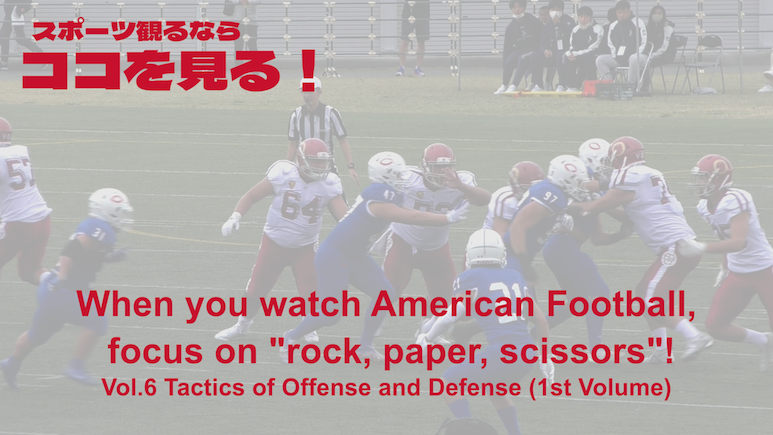
コメントを残す